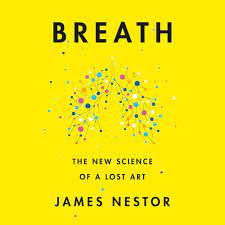Author: James Nestor
ISBN: 976-0-7352-1361-6
APA Style Citation
Nestor, J. (2020). Breath: The new science of a lost art. Riverhead Books.
Buy this book:
https://www.amazon.com/Breath-New-Science-Lost-Art/dp/0735213615
| breath_activity_.pdf |
We breathe thousands of times per day, but according to James Nestor, at least half of the population is doing it wrong. Nestor is a science writer who has been studying the research behind breathing better. He has found endless evidence dating back thousands of years and proposes some simple approaches to modifications in breathing that can lead to living with fewer ailments, diseases, and sleep disorders.
Primarily, and perhaps, most importantly, Nestor recommends breathing through the nose whenever possible. The nose serves as a filter and humidifies the air as it travels toward the lungs. Those who breathe through the mouth are more susceptible to illnesses and respiratory problems. Long-term mouth breathing can even change the shape of the face by narrowing the mouth and making it more difficult to breathe deeply. Mouth breathing can also lead to crooked teeth and a slack jaw. This slack jaw creates problems, such as snoring and sleep apnea. Over many generations, human faces have become longer and narrower, which often limits the air that comes into the body. Further, some people undergo plastic surgery procedures that slim their nose and nasal passages, inhibiting their ability to breathe well. Wide faces and broad jaws help facilitate larger airways and smoother breathing.
While it is more difficult to breathe through the nose, it leads to 20 percent more oxygen than breathing through the mouth. Nestor examines skulls from all over the world and notices the differences between modern skulls and ancient skulls. The teeth of modern peoples no longer fit into their mouths as faces have gotten thinner. While this might be aesthetically pleasing, it is not beneficial for our health. Orthodontists indicate the thinning of the mouth increases the necessity for teeth straightening. Nestor notes that ancient skulls all had straight teeth because there was more room in the mouth, which also led to more room in the air pathways.
Nestor uses himself as a subject with Stanford sleep researchers. In the first part of the study, he lives for two weeks with silicon balls placed in his nasal passages, forcing him to become a mouth breather. Nestor’s partner in the study is Anders Olsen, from Sweden, who has long been interested in research on breathing. Each day the two take their pulse and other vitals and wear a device that measures oxygen in the blood and heart rate. The men try to go about their normal day but feel sluggish and tired when forced to mouth breathe. Nestor also records any sleep apnea episodes and audio throughout the night, along with a night vision security camera to track his movements. On the first night of the mouth breathing study, Nestor’s snoring increased by 1300 percent, and his sleep apnea increased four times.
In the second part of the study, Nestor tapes his mouth shut while he sleeps to keep his nasal breathing continuing while he sleeps. While this is difficult at first, it becomes more and more of a habit as he gets used to leaving the tape on his mouth night after night. Within a day of changing to nose breathing, Nestor’s and Olsen’s vital signs returned to normal. Nestor explains that when we are mouth breathing, we are placing undue strain on our bodies and causing ailments that could easily be prevented.
Nestor recommends practicing breathing better by breathing in the nose for 5.5 seconds, holding the breath for as long as possible, and then exhaling for 5.5 seconds. With practice, these long, deep breaths become more of a habit. When we breathe deeply, we activate the parasympathetic nervous system, which helps calm the body. This is in contrast to short, shallow breaths, which occur when somebody is hyperventilating or experiencing an asthma attack. In this case, the sympathetic nervous system causes a fight-or-flight response, causing the body to panic. We should use all of our lungs to take deep, long breaths, and we should expel all of that air before intaking new air. Nestor encourages counting when breathing in, holding the air as long as possible, and then counting to five or six while expelling that air. Again, he emphasizes the importance of breathing in using the nose
This slow breathing is also known as resonant breathing and has many of the same health benefits as meditation. Some Olympic swimmers and marathon runners have significantly improved their performance using this method. Alternate nasal breathing is another method used in many ancient yoga practices. Hold one side of the nose closed while breathing deeply, holding the breath, and then letting go. Sitting upright by elongating the spine and trying to touch the shoulder blades will open up the chest. Each technique that Nestor recommends comes from years of research and is backed by science. The book ends with many recommendations for better breathing and, thus better health. Practice can make these breathing techniques them become routine over time. Nestor recommends we do this for the myriad of short- and long-term health benefits.
Other Related Resources
James Nestor Website
https://www.mrjamesnestor.com
Breathing Exercises with James Nestor
https://www.youtube.com/watch?v=itlRu-nTd9s
The Guardian: How one hour of slow breathing changed my life: James Nestor
https://www.theguardian.com/lifeandstyle/2020/jul/26/every-breath-you-take-the-lost-art-of-breathing
Lewis Howes Podcast: The truth about breathing and why you are doing it wrong.
https://www.youtube.com/watch?v=TD2PNVzzoZY
CBC Sunday Magazine: How we breathe has major impacts on our body, James Nestor’s recommendations for improving it.
https://www.cbc.ca/radio/sunday/the-sunday-magazine-for-january-17-2021-1.5874646/how-we-breathe-has-major-impacts-on-our-body-james-nestor-has-recommendations-to-improve-it-1.5874681
Stephanie’s business books: Three lessons from James Nestor’s book breath
https://medium.com/stephs-business-bookshelf/three-lessons-from-the-book-breath-by-james-nestor-272c9f56b7a8
Psychological Figures and Concepts
Anxiety
Autonomic nervous system
Fight-or-flight
Neuropsychology
Parasympathetic nervous system
Sleep apnea
Stress
Sympathetic nervous system

 RSS Feed
RSS Feed